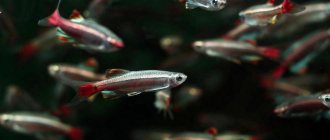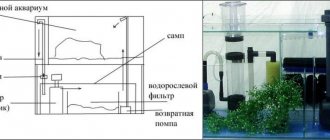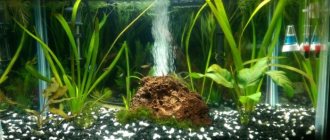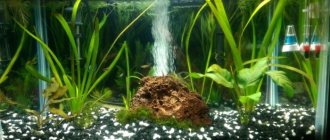4.6
(68)
Every novice aquarist, when buying his first aquarium, thinks about who will live in it. This question is complex, since on the modern market there are incredibly many different beautiful fish that differ in price, appearance, conditions of detention and other characteristics.
It is not easy to finally decide, unless a lover of underwater flora and fauna wants something specific. If he doesn’t have any particular idea about who he will put in his aquarium, then it is better to purchase unpretentious types of fish.
Why is it better to start with unpretentious ones?
Of course, anyone can buy any aquarium inhabitants that they like. But practice shows that it is better for novice aquarists to start with species that are particularly easy to care for.
This is explained as follows:
- Water parameters. All underwater pets, which can be classified as “unpretentious,” feel quite good in any water conditions. That is, hardness, acidity and even temperature are not particularly important to them. They do not need strong and thorough filtration. As a rule, a conventional internal filter with a sponge that provides mechanical cleaning is sufficient. As for aeration, it all depends on the aquarium itself. If there are enough living plants there, then a compressor most likely will not be needed. Moreover, representatives of the creeper suborder (guramis, macropods, laliuses, cockerels) even have an organ thanks to which they breathe ordinary atmospheric oxygen;
- Compatibility. All unpretentious fish are peaceful, and therefore can be considered universal. That is, they are combined with many other types. Therefore, an aquarist can take several different schools (for example, neon, zebrafish, minor, rasbor, etc.). They will definitely get along with each other and will delight the owner with their variety of colors and habits;
- Aquarium volume. One of the main advantages of such pets is that you do not need to buy spacious “houses” for them. Often a small aquarium of 10-50 liters is enough. As for calculating the number of individuals, it all depends on their size. For example, guppies are quite small, and 2 liters is enough for them. per representative. Swordtails reach 8-12 cm, and they already need 5 liters, Sumatran barbs - 10 liters.
Well, of course, all these fish are not particularly picky about food, lighting and the frequency of water changes. They are hardy and can withstand heavy loads. Although it is better not to force them to live in a stressful situation, because this can shorten their life expectancy.
Guppies Poecilia reticulata var.
Guppies are small, bright, active, mischievous schooling fish, perfect for beginners! For several centuries, these fish have been the favorite among aquarists. They are unpretentious, adapt well to the aquarium, get along well with other small peaceful fish and, of course, are very elegant and beautiful! A flock of colorful guppies with luxurious tails in an aquarium is fascinating.
Another feature of these fish is viviparity. The female does not spawn, but gives birth to fry that are already formed and ready to swim independently. This process can take place in a community aquarium (with a large number of plants and decorations) and is very interesting.
Which fish should you not start with?
Some people, when visiting pet stores, often do not know what they want to see in their aquarium. They are not particularly knowledgeable about certain families. Employees, in turn, will be very happy to sell someone at a higher price, without caring about the conditions in which the animal will live.
It is difficult to list everyone unequivocally, but we can mention those who occur frequently:
Black pacu . Visually, it can be confused with a piranha, and this is not surprising, because it is a “relative” of the famous predator. In stores, one individual will be about 5-7 cm long, but this does not mean that it will remain that way forever. After just a few months, she is able to outgrow even a 200-liter aquarium, reaching a weight of 4 kg and a height of 40 cm. The black pacu is suitable for those who can provide them with a whole ton of liters of space, literally;
Black pacu
Two-color labeo. It may slightly resemble a shark, but at the same time it has an interesting color, due to which it attracts the attention of beginners. The difficulty of keeping it lies in both its size and aggressive behavior. If there are residents of similar color or related in color next to him, then persecution and constant fights cannot be avoided;
Two-color labeo
Brocade pterygoplicht . Outwardly, a completely harmless catfish, in many ways similar to ancistrus. However, the buyer will soon realize that he made a mistake with his choice. The thing is that pterygoplichts quickly grow to incredible sizes (up to 50 cm), and there is no point in putting them in aquariums smaller than half a ton;
The brocade pterygoplichthus belongs to the chain-mail catfish family.
Astronotus . Also often found on sale. It looks unusual and beautiful, but behind this appearance lies a complex character. Astronotus are extremely aggressive and will eat anyone who can fit in their mouth. In addition, they need a house starting from 200 liters, but then they will have to transplant it into a half-ton;
Astronotus tiger
African cichlids . Incredibly attractive and similar to their sea relatives. However, they are also very aggressive and will kill any competitors that may lay claim to their territory. Well, and besides, they need good filtration and frequent water changes.
Pseudotropheus demasoni. A species of African cichlid.
Listed above are the most popular types of fish in stores. In addition to them, you can also distinguish discus, arowana, shark balu, glass catfish, koi carp and axolotl, although the latter are salamander larvae.
Common marbled gourami Trichogaster trichopterus - var.
Marbled gourami is an interesting and very unpretentious fish from the labyrinthine family. Gourami are beautiful and elegant, perfect for both professionals and beginners. Gouramis stay in the upper third of the aquarium; their pectoral fins have turned into thin probe threads, which additionally help the fish navigate in the water.
These fish grow up to 10-12 cm. They are perfect for community aquariums with peaceful inhabitants. A special feature of gourami is the presence of a labyrinth organ that allows the fish to breathe atmospheric air.
Top most unpretentious aquarium fish
Now we can select those underwater pets who will not create problems when kept. There are also an incredible number of them, and most of them are compatible with each other.
Guppy
Endler's guppy
Perhaps it’s difficult to name them more popular. They are extremely tenacious and everyone involved in aquarium farming speaks about this. They belong to the poeciliaceae family. Their main feature is that females are significantly larger than males. The latter are not only smaller, but also have a brighter color. They have long veil fins, which attract the attention of beginners.
Guppies feel comfortable at a temperature of 18-28 degrees and in general are a model of unpretentiousness. But it is worth considering that they are viviparous, and therefore their population can grow rapidly if this is not monitored.
Swordtails
Calico Swordtail
They are distinguished by a relatively calm and peaceful character. Males are smaller and slimmer than females and are distinguished by a sword-shaped appendage on their tail, which is where the name comes from. They can live comfortably in small aquariums. The optimal temperature is 22-26 °, but can withstand even 15 ° C. They belong to the same family as guppies. During spawning, females produce fry ready for life. Reproduction is possible both in a fish tank and in a general aquarium.
They feed on both plant and animal food. They will feel more comfortable if there is a lot of vegetation and shelter nearby. They are quite active and interesting, but it is better to install a lid or glass over the water so that the individuals do not accidentally jump out.
Catfish
Catfish Corridors Panda
This is a whole genus of ray-finned fish belonging to the catfish family. Therefore, it is impossible to clearly state the conditions of their detention. Some representatives grow no more than 10 cm, while others reach a length of 5 m.
Unpretentious fish include the genus Corydoras (shellfish). They are very peaceful and interesting. They swim in schools and arrange real hide and seek among themselves. Optimal conditions are 20-26 degrees, soft water with weak acidity.
Ancistrus vulgaris
You can also distinguish cockroaches . They need a larger aquarium, but they get along with almost everyone. Thanks to their shell, even predators are not afraid of them. They live for about 10 years. They prefer, like any catfish, the presence of shelters made of snags, stones and plants.
Well, and of course, don’t forget about ancistrus . They are not at all picky about conditions. Water 20-28° is suitable for them. They live for about 7 years and grow up to 10 cm. They love plant foods, and therefore you can even throw all sorts of vegetables (cucumbers, zucchini, pumpkin, dandelion leaves) with them. It is worth noting that this is a very useful inhabitant, which thoroughly cleans the glass and bottom if there are leftover food from neighbors.
Danio
Danio rerio
They belong to the carp family. They are very popular due to the variety of colors. They are quite peaceful and live in flocks, which makes them look even more attractive. They grow small, 2-4 cm. They can be fed with both dry and frozen food. Temperature – 20-25°C.
Barbs
Barbus cherry
They amaze with their diversity. They are related to the zebrafish family. Very active and diverse. They love to have plenty of space to swim. Quite peaceful in nature, but incompatible with those neighbors that have long veiled fins.
Neons
Red neon
Also famous representatives of the underwater world. They belong to the Characion family. They are distinguished by their bright colors. They have a neon stripe on their body, which can have different colors depending on the species. They like cool water around 18-22°. They also need a lot of plants so they can hide. It is advisable that the aquarium have places without currents, where they would feel calm. They look great in flocks of 5 or more individuals.
Cardinals
Cardinal gold
Also beautiful animals from the order Cyprinidae. In many ways they are similar to neons (especially in temperature conditions), although they are not related. They love currents and swim in schools of 6-8 pieces. They are not picky about food, nor are they picky about water parameters.
Tetras
Lemon tetra
Common name for Characion fish. What they all have in common is that they are not very big and do not like being alone at all. They combine well with each other, but it is better not to plant them with barbs and the like, as they can take food. Temperature range – 22-25°C.
Mollies
Black mollies
Direct relatives of swordtails. Also universal in terms of water parameters. Viviparous, peaceful and nimble, which makes them interesting. They are not difficult to propagate, which is why beginners often take them.
Cockerel
Crown-tailed cockerel
One of the most beautiful representatives of underwater fauna. They have a bright color and elegant wide fins. One individual must be allocated a volume of 3 liters. They prefer warm water – 25-28°C. Aeration is not needed; they breathe ordinary oxygen. You should not put two males in one container, otherwise they will fight to death. They also do not like small and slow neighbors.
Angelfish
Marbled angelfish
The cichlid family, but clearly different from their counterparts. They have an unusual flat and triangular shape. Temperature range – 24-28°C. They feed on live food. Angelfish are relatively calm in character, but they always find a favorite place from which they kick out all the other neighbors. The main nuance is that for one individual you need to allocate at least 50 liters, since they grow quite large.
Home aquarium base
Regardless of how tenacious fish have won the heart of a beginner, he will have to take care of the basic arrangement of the aquarium. Those who want to enjoy aquarium keeping should buy:
- The aquarium itself;
- Filter;
- Compressor;
- Priming;
- Water conditioner if tap water is too chlorinated or hard.
Capacity
Each aquarium has parameters that are important for beginners:
- Volume.
The larger the capacity, the wider the possibilities for creating a beautiful underwater world. A small aquarium requires no less care than a large one. Among experienced aquarists, the following values are accepted:
- 15-30 l – micro aquarium;
- 30-50 l – small;
- 50-100 l – small;
- 100-150 l – average;
- 150-300 l – good, normal;
- from 300 l – large.
Among beginners who want to create a truly paradise for pets, small containers from 50 to 100 liters are popular.
- Form.
The variety of shapes in a pet store amazes beginners: high and low, rectangular, round, triangular and square, with panoramic glass, in the form of a pillar... To make the right choice, inspect the room where you plan to place the tank:
- Having a place away from direct sunlight;
- Possibility to install an aquarium cabinet;
- Convenient location.
It is strictly not recommended to move the aquarium, so you need to take care of its location in advance.
Water
Clean water is the key to success in keeping any fish. Unpretentious ones are able to withstand large variations in each parameter: acidity, hardness, temperature. But not a single fish can live in water where chlorine and nitrogen compounds are exceeded. If the tap water you plan to pour into the aquarium is too chlorinated, it will be enough to use a special conditioner each time you change it. Or let the water sit for 2-3 days.
Filter
Well-established filtration guarantees water purity. Filters are:
- Internal – for aquariums up to 100 l;
- External - installed in containers over 100 liters.
It is impossible to keep even the most unpretentious aquarium fish in an aquarium without a filter; this significantly affects the duration and quality of their life.
Compressor
Aeration is necessary for most fish, but some can do without it. It is better to aerate the water with a separate compressor, but if the fish are unpretentious, an aerator combined with a filter will suit them.
Priming
An obligatory element of the biotope. Residues of feed and waste products settle into the soil, which slows down water pollution with nitrogen compounds. This should not be ignored; the fish feel uncomfortable without soil.
Tarakatum
This is another very beautiful spotted catfish. Since the fish reach quite large sizes, the volume of the container should be at least 100 liters. A filter and timely water change will be required - these fish have a strong appetite, which is why they produce quite a lot of waste.
Cockroaches are fed with special ready-made food for catfish and add natural food - bloodworms, shrimp meat and peeled earthworms.
Macropods
Macropods - Another, although not whimsical, but extremely aggressive fish. Macropods almost always come into conflict with other inhabitants of the aquarium. Moreover, in their attempts to eliminate neighbors of another species, they are extremely inventive. Macropods can tear out an eye, tear off a fin, and sometimes even kill. Macropods do not get along at all with fish of the veiltail and telescope families. The only advantage of this species is its complete indifference to living conditions: water temperature and filtration are not important to them. Owners of macropods are not advised to forget to feed their fish.
Maecenobears
Swordfish - the fish has a golden-coral color (one might even say almost red). It is quite easy to distinguish a female swordtail from a male. The female is larger in size, and the male has elongated lower tail fins. The male's tail resembles the tip of a sword. The fish got their name for this feature. Swordtails are also viviparous fish, although they cannot be called friendly. This is due to the fact that adults are capable of eating their offspring immediately after birth. To prevent this from happening, the owner should carefully monitor the female and, by the time the birth process approaches (this is immediately clear from the almost transparent rounded abdomen), place the female separately, and after birth, place the fry. Swordtails should be fed once a day. The fish is extremely voracious.
Danio
The English name for this striped fish translates to “zebra fish.” She really has a very interesting color with dark stripes on a light background.
Danios are extremely unpretentious in their diet; it is best to use dry fish food of a small fraction and periodically supplement with live or frozen protein food.
An aquarium with a volume of about 50 liters is suitable. Fish need sufficient oxygen and clean water, so you need to plant a sufficient number of aquatic plants in the tank and install a filter.
Siamese cockerel "Siamese crown" Betta splendens var.
The Siamese cockerel is truly a decoration for any aquarium with peaceful inhabitants. The only thing that upsets me is that only one male betta can live in one aquarium. These fish are extremely aggressive towards male members of their species, hence the common name “betta fish”. They grow about 5-6 cm.
Male bettas have luxurious tails and fins. There is no limit to the variety of their colors: red, green, white, blue, silver, black, yellow and others. At the same time, the cockerels are very tenacious and unpretentious. This is what makes them desirable pets in the home aquarium.
Angelfish
Graceful and attractive fish are also considered unpretentious; they lead a calm and measured lifestyle and are distinguished by a peaceful disposition. With good care they can grow up to 15 centimeters, so the size of the aquarium must be appropriate. Angelfish love warm water - 24-26 degrees, but it is better to avoid sudden temperature changes; be sure to have shelters and plants in the aquarium where angelfish can hide. For feeding, angelfish are suitable for both live and dry food; they can only be kept with peace-loving fish.
Pecilia
Platies are quite fertile and viviparous fish. Most often it has a golden-red-orange color. Although in recent years, aquarium platies are becoming more and more often painted in different colors. The fish tolerates hard water very well (of course, you can’t just pour tap water on it) and a small amount of oxygen. The fish feeds mainly on special food. It is enough to feed once a day. Pisces have an extremely calm and peaceful character.
Labyrinthine
These air-breathing fish are the largest of all unpretentious fish. They do not need to carry out additional aeration of the water, since they do not receive oxygen from it. It is important that there is space between the aquarium lid and the water so that the pets have the opportunity to take a breath of air.
Macropod (paradise fish)
Hardy, bright fish up to 9 cm long. Males are aggressive towards fish of other species and males of their own species. It is optimal to keep a pair of macropods whose behavior is interesting to observe. Spawning is easy. The male builds a nest of air bubbles into which the eggs are placed and takes care of it until the larvae emerge from the eggs.
Cockerel (Siamese fighting fish)
Fishes have a variety of colors. Males are especially decorative. They do well in small and medium containers. You cannot keep more than 1 male in an aquarium, but it is advisable to place several females, but not in crowded conditions. Due to their cocky nature, bettas should not be combined with veiled fish. The cockerels will quickly tear off their fins, causing them to die. Ideally, have a species aquarium.
Gourami and lalius
It is allowed to have them only if you have a spacious aquarium with a volume of 80 liters or more. Pets will need an abundance of living plants and stable water temperatures. For them, a high concentration of nitrites and nitrates in water is unacceptable. It is recommended for a beginner to get these fish only if he is ready to devote a lot of time to the aquarium.
Corridoras
These are small armored catfish that are small in size: from 3 to 12 centimeters. A special feature of this species is the ability to breathe atmospherically, therefore, when setting up an aquarium, it is necessary to provide free access for catfish to the surface of the water. It is best to keep Corydoras in groups; make sure there are plants and shelters. They are not too demanding on the quality of water; the temperature can range from 17 to 32 degrees. These are bottom-dwelling fish, so food must be selected so that it falls to the bottom. 30% of the total volume of the aquarium needs to be changed regularly.











